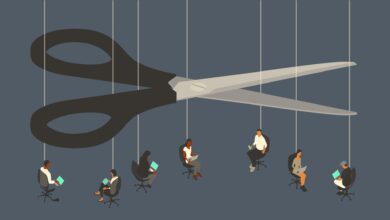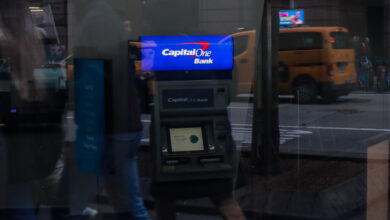U.S. adds 199,000 jobs in November, as slow down in the labor market continues

Still, the unemployment rate has stayed below 4 percent for two years, a stretch last accomplished in the 1960s, giving workers leverage to demand raises and switch into better jobs.
A handful of industries, especially those less sensitive to interest rate hikes such as health care and government, are now fueling job growth and keeping the economy firmly out of a recession that analysts had widely feared just a year ago.
“The overall picture is one of a solid labor market that is slowing gradually, not falling off a cliff,” said Julia Pollak, chief economist at Zip Recruiter. “The breadth of job gains is all in health care and government. The rest of the economy has ground to a halt. That’s the effect of high interest rates.”
Health care added 77,000 jobs in November, mainly in ambulatory health-care services, hospitals and nursing-care facilities. Government added 49,000 jobs in November, finally catching up to its pre-pandemic employment levels the previous month, as wages in state and local government have caught up with the private sector.
Manufacturing also trended up by 28,000, reflecting the return of union auto-manufacturing workers from their strike. Leisure and hospitality added nearly 40,000 jobs, mostly at restaurants and bars, after months of choppy growth.
Other industries showed negative or sluggish jobs creation. Retail lost 38,000 jobs in November, according to seasonally adjusted data, as holiday season hiring has not been as strong as past years, possibly due to a shift to self-checkout. Transportation and warehousing, construction, financial services and the information sector showed little change. Within the information sector, job losses in broadcasting, publishing, and other industries were offset job gains triggered by the resolution of Hollywood strikes.
The major stock indexes wavered on the news of November’s job gains, with traders remaining cautious to demonstrate certainty that the Federal Reserve will move to lower interest rates in 2024.
Acting Labor Secretary Julie Su told The Washington Post that November’s jobs numbers were “strong,” and offered evidence that the Biden administration’s policies to boost the middle class have worked.
The Federal Reserve, which has lifted interest rates to the highest level in 22 years to bring down inflation, appears to have achieved soft landing conditions this year. Demand has eased in the labor market and wage growth has slowed, bringing down inflation to 3.2 percent over the year in October, without triggering catastrophic job losses so far.
Consumer dread about rising prices appears to be receding, with the University of Michigan’s consumer sentiment index rising in December, according to new data released Friday. Economists caution that it remains too early to see the full impact of the rate hikes.
Wage growth moderated in November, rising by 4 percent over the previous 12 months in November, to $34.10 an hour. That is good news for workers. As wage growth has tempered since earlier this year, inflation has slowed more, meaning average hourly earnings are beating price increases, boosting Americans’ spending power.
“This is encouraging for central bankers and the people getting real wage gains,” Nick Bunker, economic research director at the jobs site Indeed said. “It’s helping people spend more which is good for GDP growth and for everyone. It’s a win-win for a variety of audiences.”
Investors are optimistic that the softening in the labor market will spur the Fed to cut rates early next year, which has spurred enthusiasm in the financial markets and could lead to stronger job growth later in 2024. Friday’s jobs report provides one of the last snapshots of the labor market before the Fed meets Tuesday and Wednesday to consider policy on interest rates, which are designed to curb inflation.
By most measures, the labor market remains just as strong or stronger than the years leading up to the pandemic, a period marked by low unemployment and hardy job growth. Layoffs remained low in October, according to the Labor Department’s job openings survey released Tuesday, despite some concentrated pockets of job losses in finance, tech and media. The number of Americans working part time because they were unable to find more work decreased by 295,000 in November, as the average workweek edged up.
Meanwhile, job openings have dropped substantially from their peak at 12 million in March 2022 down to 8.7 million jobs in October, according to the Tuesday report, in a sign that employers are no longer on a hiring frenzy. The low layoff rate is a sign that employers are acting cautiously, holding on to workers despite tempered demand, after years of competing for labor.
“Employers aren’t willing to close their eyes and pay for labor anymore,” said Drew Matus, chief market strategist at MetLife Investment Management. “But they’re paying attention to who and what they need. And they’re thinking, what if everything gets so much better and I’m understaffed? Some of that is a hangover from the covid experience.”
The share of Americans participating in the labor force, at 62.8 percent, a figure closely watched by policymakers, is at its highest point since the start of the coronavirus pandemic, but remains below its pre-pandemic levels, largely to due to the retirements of baby boomers. The influx of immigrants arriving in the United States this year and the strong return of women to the labor market has pushed the rate of participation for 25 to 54-year-olds to its highest levels since before the Great Recession of 2008.
Pollak, the Zip Recruiter economist, said that the rate of workers entering the labor force may be too fast “to keep unemployment this low” going into the new year. She expects more gradual labor market cooling at the start of 2024, but said that “many industries are in a fantastic position” to expand again when the Fed begins cutting rates.





